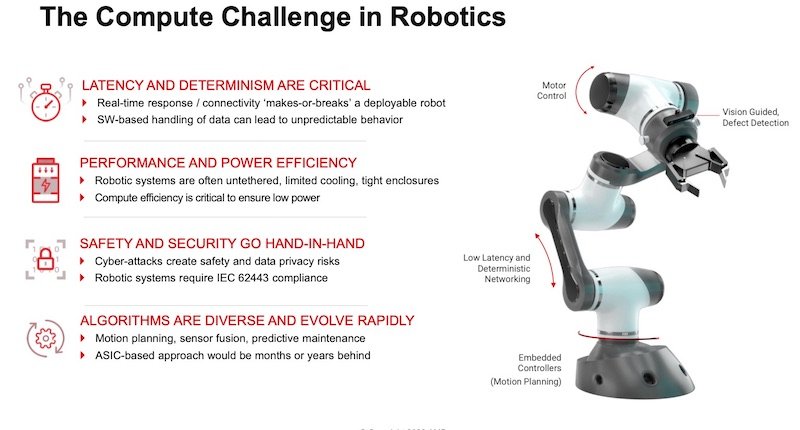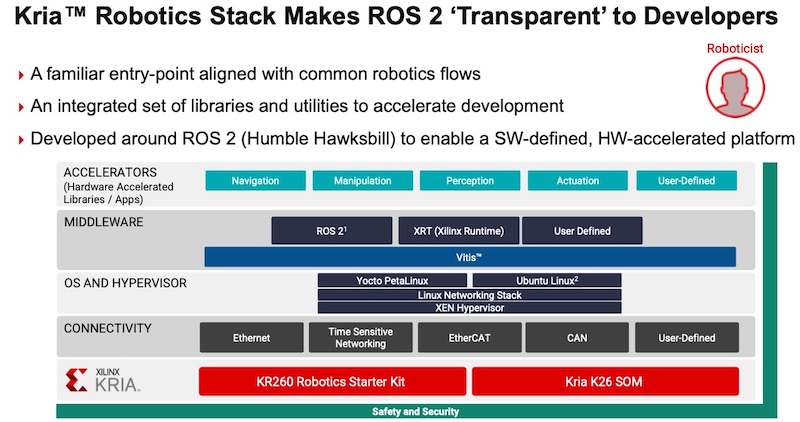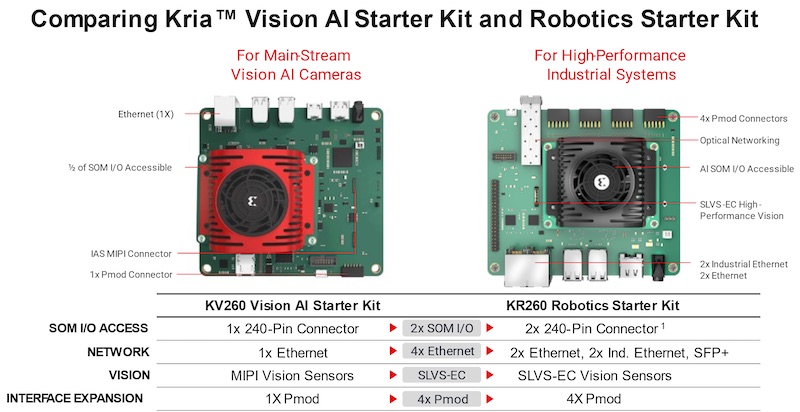A little over a year ago, AMD (formerly Xilinx ) launched its first Kria SOM (system-on-module) product, the Kria K26. Today, the company is introducing its Kria KR260 Robotics Starter Kit. Aimed at accelerating industrial robotics designs, the kit leverages its adaptive SoC technology, ROS 2 (Robot Operating System 2), and its “app store” approach to pre-built robotics interfaces. The company is showcasing this new product at this week’s 2022 Embedded Vision Summit.
In this article, we look at the problem the KR260 is aiming to solve for robotic system developers, and we share insights and perspectives from our interview with Chetan Khona, AMD’s Senior Director for Industrial, Vision, Healthcare, and Sciences.
Limitations of Custom Robot Designs
First off, we asked Khona: Why is it so hard to meet today’s industrial demands using traditional approaches to robot designs?
There are serious design issues holding back the widespread adoption of robotics. The problem with the state of technology for robotics today, says Khona, is that industrial robots tend to be purpose-built. In other words, they are essentially what Khona describes as “bespoke systems handcrafted for a specific task.”

There are many computing challenges in robotics that make custom implementations problematic. Image used courtesy of AMD
The problem with these highly customized robots is that you can’t use that approach for a commercially viable robot capable of addressing lots of use cases, says Khona. At the same time, the available building blocks for an intelligent robot—control algorithms, communication standards, AI, sensor types—are in a constant state of change. All these factors point to the need for a software-defined robot.
With all that in mind, AMD’s new Kria KR260 Robotics Starter Kit combines the elements needed for software-defined robot development. The kit provides native ROS 2 support and pre-built interfaces for industrial robotics. All of that is supplemented by a growing set of accelerated “apps” provided on AMD–Xilinx’s App Store.
Bringing ROS 2 Into the Commercial Realm
An important piece of enabling software-defined robots is the open middleware known as ROS. “To understand ROS, you need to understand the problem roboticists are trying to solve,” says Khona, “robots are a system-of-systems.”
"Robotics is the art of system integration because you've got a camera subsystem, you've got a motor control subsystem, you've got a sensor subsystem—each of these systems are a world unto themselves. But then you need to connect these systems and have them transmit and receive and process data in a timely and coordinated way."
For its part, ROS (version 1) has gained wide adoption and support in the open-source community and academia, but it’s never gained traction in the commercial industry. “This is where ROS 2 comes in,” says Khona. He stresses that ROS 2 has important features that were left out of its predecessor. Importantly, ROS 2 allows control, message-passing, and implementation of common functionality via libraries, C++, Python, etc.
ROS 2 itself has yet to catch on in the industry; however, Khona says that now is the right time for it to shine “because we believe the next wave of robotics designed by industry will not be proprietary...[t]hey will be ROS 2-based." Using a ROS 2-based solution like AMD’s KR260 hardware platform could enable engineers to use adaptive computing and hardware acceleration on ROS 2, he says.
Kria Robotics Stack Glues it All Together
Despite its name, ROS/ROS 2 is best thought of as middleware, not an operating system. A framework is needed to connect ROS 2 to AMD’s FPGA-based technology and an actual operating system such as Linux. AMD does this with a new tool it calls Kria Robotics Stack (KRS). KRS is an integrated set of robot libraries and utilities built around ROS 2 and it uses ROS 2 as its SDK.

The Kria Robotics Stack is an integrated collection of robot libraries and utilities built around ROS 2. Image used courtesy of AMD
Part of KRS is AMD’s well-established Xilinx FPGA tools Vitis and VIVADO. In KRS, as Khona describes, when you’re compiling your design with KRS, it's calling Vitis and VIVADO under the hood. It’s piecing together what you’ve described in computation graphs and data-layer-graphs with ROS 2. “KRS is actually assembling the pieces under the hood using Vitis and VIVADO to actually build the system you’ve described,” says Khona.
The KR260 claims to provide compatibility with the latest LTS (long-term support) versions of Ubuntu Linux Desktop (22.04) from Canonical and ROS 2 Humble Hawksbill. Coincidentally, those latest versions of Ubuntu and ROS 2 are being released this month. Khona says AMD is collaborating with Open Robotics, the creators of ROS 2 and other open software and hardware platforms for robotics, in order to validate and ensure compliance with its ROS 2 implementation.
An App Store Model for Robotics Functions
With the release of the KR260 Starter Kit, AMD is expanding on its concept of an “App Store” model that the company introduced with its Kria KV260 Vision AI Starter Kit last year. Several apps are already available for the earlier KV260 kit. All these apps are pre-built applications for evaluation with no FPGA expertise required. Each app converts the SOM into a function-specific node.

Part of AMD’s embedded “App Store," these production-ready apps are available from both AMD and its partners. Image used courtesy of AMD
The three new apps being announced in conjunction with the KR260 include a TSN (time-sensitive networking) app, a 10 GigE vision app, and a perception app. As shown in the image above, AMD is planning to add a number of apps in the future, such as AI, ultrasound imaging, and navigation node apps.
Using these predefined apps, robot designers could be up and running in less than one hour, claims the company.
Out of the box, AMD says that engineers can:
- Connect peripherals and cables
- Insert the programmed MicroSD card
- Power-on the KR260 board
- Load accelerated app of choice
- Run the accelerated app
Once a robotic system is developed using the starter kit, a functionally identical K26 SOM could be deployed in the final production robotic system.
Hardware Features for Robotics
In terms of hardware, the Kria KR260 Robotics Starter Kit offers a number of features aimed at industrial robotics. Two TSN ports with built-in switches eliminate the need for an external TSN switch. Accurate time synchronization is enabled over Ethernet (IEEE Std 802.1AS).

The Kria KR260 Robotics Starter Kit improves on the earlier KV260 kit, adding SLVS-EC camera support, Industrial Ethernet, optical networking, and more. Image used courtesy of AMD
The board’s Ethernet has support for converged traffic classes and data types. High-performance machine vision is enabled thanks to an SLVS-EC sensor RX connector. An SFP+ 10 G cage supports 10 GigE machine vision. The board leverages Modbus over Pmod for actuation.
Accelerated Demand for Industrial Robots
To put things into perspective, we asked Khona why the demand for industrial robotics is particularly high now. In the aftermath of the pandemic and its associated supply chain challenges, factories worldwide need more flexibility, he says. They have to build what they can build based on what their supply situation looks like in order to stay productive. Such challenges are exacerbated by labor shortages. All that leads to increased demand for more robotics in factories.
“What our customers tell us about factories today is basically that the walls are fixed, but everything else is adaptable. In this world, robots are a key enabler of what we like to say is the connected, autonomous, higher performance and higher efficiency factory.”
If Khona is right about today’s growing demand for industrial robotics, it’s clear that scalable, software-defined robot implementations like AMD’s KR260 Starter kit could provide a path to serve those needs.
